Numerical Study of a Polarization Selective Visual Optical Switch
Abstract
:1. Introduction
2. Design and Modeling
3. Results and Discussions
3.1. The Influence of the Number of Metal Strips on the Enhanced Optical Transmission
3.2. The Influence of the Changing between the Different Geometric Parts of the Structure on the Enhanced Optical Transmission
3.3. The Influence of the Changing of Metal Strip Material on the Enhanced Optical Transmission
4. Conclusions
Author Contributions
Funding
Conflicts of Interest
References
- Ghaemi, H.F.; Thio, T.; Grupp, D.E.; Ebbesen, T.W.; Lezec, H.J. Surface plasmons enhance optical transmission through subwavelength holes. Phys. Rev. B 1998, 58, 6779–6782. [Google Scholar] [CrossRef] [Green Version]
- Barnes, W.L.; Dereux, A.; Ebbesen, T.W. Surface plasmon subwavelength Optics. Nature 2003, 424, 824–830. [Google Scholar] [CrossRef] [PubMed]
- Lin, L.; Roberts, A. Light transmission through nanostructured metallic films: coupling between surface waves and localized resonances. Opt. Express 2011, 19, 2626–2633. [Google Scholar] [CrossRef] [PubMed]
- Garcia, V.F.J.; Moreno, L.M.; Ebbesen, T.W.; Kuipers, L. Light passing through subwavelength apertures. Rev. Mod. Phys. 2010, 82, 729–787. [Google Scholar] [CrossRef] [Green Version]
- Jongkyoon, P.; Hyunsoo, L.; Alexander, G.; Kyujung, K.; Seungchui, K. Spectral shifting in extraordinary optical transmission by polarization-dependent surface plasmon coupling. Plasmonics 2019, 15, 489–494. [Google Scholar]
- Yang, Z.H.; Song, Y.; Chen, S.; Gao, Y. Control of EOT of subwavelength metal bullseye structures by coaxial nano-columns. Opto-Electron. Eng. 2018, 45, 180207–180216. [Google Scholar]
- Wen, K.; Zhang, Z.J.; Jiang, X.P.; He, J.; Yang, J.B. Plasmonics induced multifunction optical device via hoof-shaped subwavelength structure. Appl. Sci. 2020, 10, 2713. [Google Scholar] [CrossRef] [Green Version]
- Wen, K.; Jiang, X.P.; He, J.; Li, G.F.; Yang, J.B. Color-adjustable devices based on the surface plasmons effect. Appl. Sci. 2020, 10, 1960. [Google Scholar] [CrossRef] [Green Version]
- Zhou, H.; Zhen, B.; Hsu, C.W.; Miller, O.D.; Johnson, S.G.; Joannopoulos, J.D.; Soljacic, M. Perfect single-sided radiation and absorption without mirrors. Optica 2016, 3, 1079–1086. [Google Scholar] [CrossRef]
- Sun, T.M.; Deng, Z.X.; Sheng, J.B.; Chen, Z.Y.; Zhu, W.H.; Guo, W.; Wang, X.L. A compact optical switch via plasmonics of subwavelength circular-sharp hole arrays in metal films. Ann. Phys. 2017, 530, 1–6. [Google Scholar] [CrossRef]
- Wang, J.; Fan, Q.; Zhang, S.; Zhang, Z.; Zhang, H.; Liang, Y.; Cao, X.; Xu, T. Ultra-thin plasmonic color filters incorporating free-standing resonant membrane waveguides with high transmission efficiency. Appl. Phys. Lett. 2017, 110, 031110–031113. [Google Scholar] [CrossRef]
- Shu, F.; Yu, F.; Peng, R.; Zhu, Y.; Xiong, B.; Fan, R.; Wang, Z.; Liu, Y.; Wang, M. Dynamic plasmonic color generation based on phase transition of vanadium dioxide. Adv. Opt. Mater. 2018, 6. [Google Scholar] [CrossRef]
- Wang, B.; Dong, F.L.; Li, Q.T.; Yang, D.; Sun, C.W.; Chen, J.J.; Song, Z.W.; Xu, L.H.; Chu, W.G.; Xiao, Y.F.; et al. Visible-frequency dielectric metasurfaces for multiwavelength achromatic and highly dispersive holograms. Nano Lett. 2016, 16, 5235–5240. [Google Scholar] [CrossRef]
- Huang, Z.; Liu, X.; Zang, J.F. Inverse design of structural color using machine learning. Nanoscale 2019, 11, 21748–21758. [Google Scholar] [CrossRef]
- Guo, T.B.; Evans, J.; Wang, N.; He, S.L. Monolithic chip-scale structural color filters fabricated with simple UV lithography. Opt. Express 2019, 27, 21646–21651. [Google Scholar] [CrossRef] [PubMed]
- Yokogawa, S.; Burgos, S.P.; Atwater, H.A. Plasmonic color filters for CMOS image sensor applications. Nano Lett. 2012, 12, 4349–4354. [Google Scholar] [CrossRef]
- Yu, Y.; Chen, Q.; Wen, L.; Hu, X.; Zhang, H. Spatial optical crosstalk in CMOS image sensors integrated with plasmonic color filters. Opt. Express 2015, 23, 21994–22003. [Google Scholar] [CrossRef] [PubMed]
- Xin, J.Z.; Hui, K.C.; Wang, K.; Chen, H.L.W.; Ong, D.H.C.; Leung, C.W. Thermal tuning of surface plasmon resonance: Ag gratings on barium strontium titanate thin films. Appl. Phys. A 2012, 107, 101–107. [Google Scholar] [CrossRef]
- Zhao, R.; Sain, B.; Wei, Q.; Tang, C.; Li, X.; Weiss, T.; Huang, L.; Wang, Y.; Zentgraf, T. Multichannel vectorial holographic display and encryption. Light. Sci. Appl. 2018, 7, 95–104. [Google Scholar] [CrossRef] [PubMed] [Green Version]
- Al-Salem, S.M.; Lettieri, P.; Baeyens, J. Recycling and recovery routes of plastic solid waste (PSW): A review. Waste Manage. 2009, 29, 2625–2643. [Google Scholar] [CrossRef] [PubMed]
- Min, C.; Wang, P.; Chen, C.; Deng, Y.; Lu, Y.; Ming, H.; Ning, T.; Zhou, Y.; Yang, G. All-optical switching in subwavelength metallic grating structure containing nonlinear optical materials. Opt. Lett. 2008, 8, 869–871. [Google Scholar] [CrossRef] [PubMed]
- Steven, L.; Daniel, C.; Bin, A.; Yiping, Z. The extraordinary optical transmission and sensing properties of Ag/Ti composite nanohole arrays. Phys. Chem. Chem. Phys. 2019, 21, 3771–3780. [Google Scholar]
- Zheng, J.P.; Zhou, J.; Zeng, P.; Liu, Y.; Shen, Y.P.; Yao, W.Z.; Chen, Z.; Wu, J.H.; Xiong, S.; Chen, Y.Q.; et al. 30 GHz surface acoustic wave transducers with extremely high mass sensitivity. Appl. Phys. Lett. 2020, 116, 123502–123511. [Google Scholar] [CrossRef] [Green Version]
- Yang, W.H.; Xiao, S.M.; Song, Q.H.; Liu, Y.L.; Wu, Y.K.; Wang, S.; Yu, J.; Han, J.C.; Tsai, D.P. All-dielectric metasurface for high-performance structural color. Nat. Commun. 2020, 11, 1864–1872. [Google Scholar] [CrossRef] [PubMed] [Green Version]
- Ruan, Z.C.; Qiu, M. Enhanced transmission through periodic arrays of subwavelength holes: the role of localized waveguide resonances. Phys. Rev. Lett. 2006, 96, 233901–233904. [Google Scholar] [CrossRef]
- Degiron, A.; Ebbesen, T.W. The role of localized surface plasmon modes in the enhanced transmission of periodic subwavelength apertures. J. Opt. A Pure Appl. Opt. 2005, 7, S90–S96. [Google Scholar] [CrossRef]
- Ameri, T.; Dennler, G.; Waldauf, C.; Azimi, H.; Seemann, A.; Forberich, K.; Hauch, J.; Scharber, M.; Hinger, K.; Brabec, C.J. Fully solution-processing route toward highly transparent polymer solar cells. Adv. Funct. Mater. 2010, 20, 1592–1598. [Google Scholar] [CrossRef]
- Chen, F.; Yao, D.Z. Tunable multiple all-optical switch based on multi-nanoresonator-coupled waveguide systems containing Kerr material. Opt. Commun. 2014, 312, 143–147. [Google Scholar] [CrossRef]
- Yang, Z.M.; Chen, Y.Q.; Zhou, Y.M.; Wang, Y.S.; Dai, P.; Zhu, X.P.; Duan, H.G. Microscopic interference full-color printing using grayscale-patterned frabry-perot resonance cavities. Adv. Opt. Mater. 2017, 5, 1700029–1700038. [Google Scholar] [CrossRef]
- Yang, Z.M.; Zhou, Y.M.; Chen, Y.Q.; Wang, Y.S.; Dai, P.; Zhang, Z.G.; Duan, H.G. Reflective color filters and monolithic color printing based on asymmetric fabry-perot cavities using nickel as a broadbang absorber. Adv. Opt. Mater. 2016, 4, 1196–1202. [Google Scholar] [CrossRef]
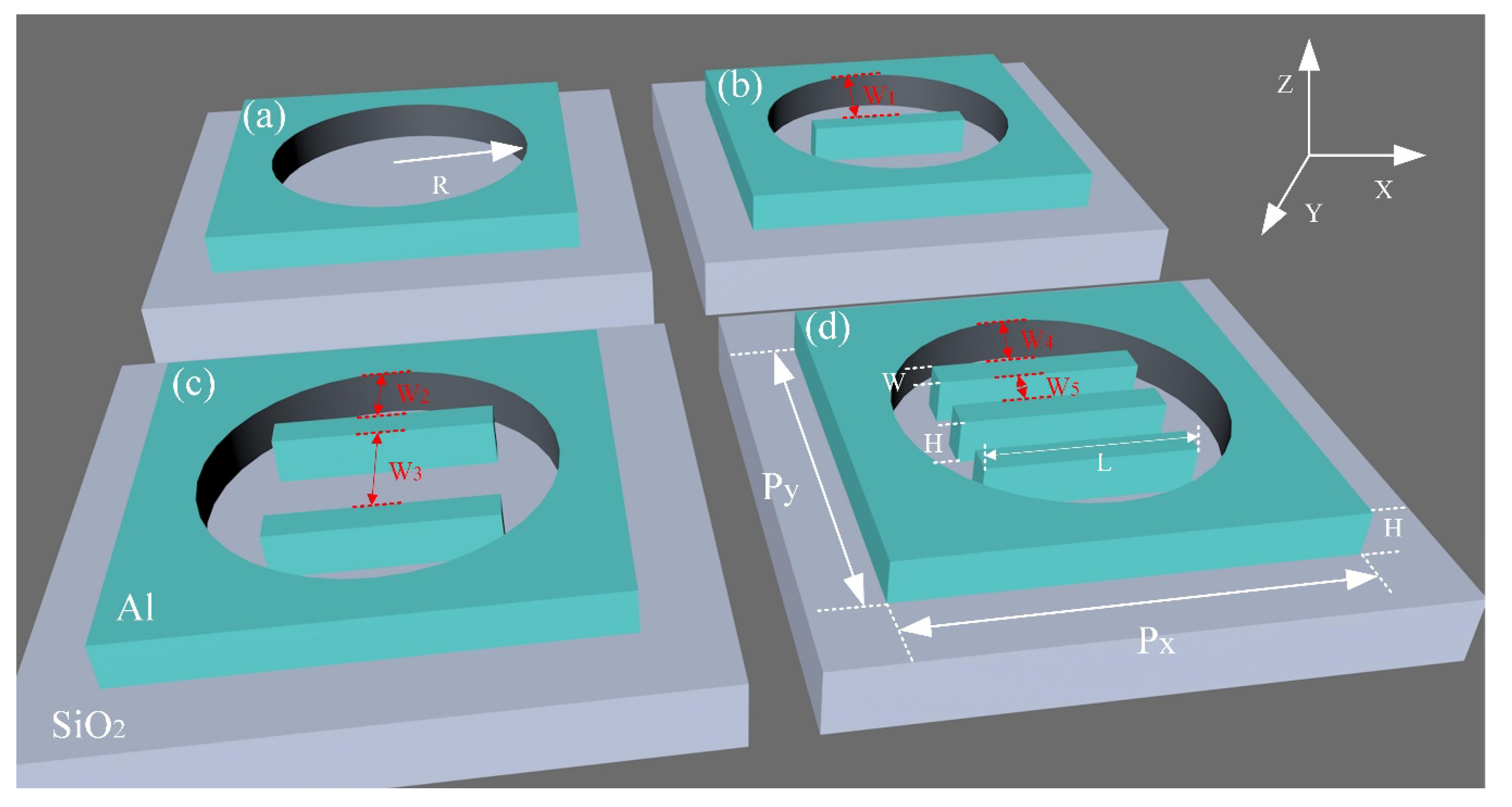

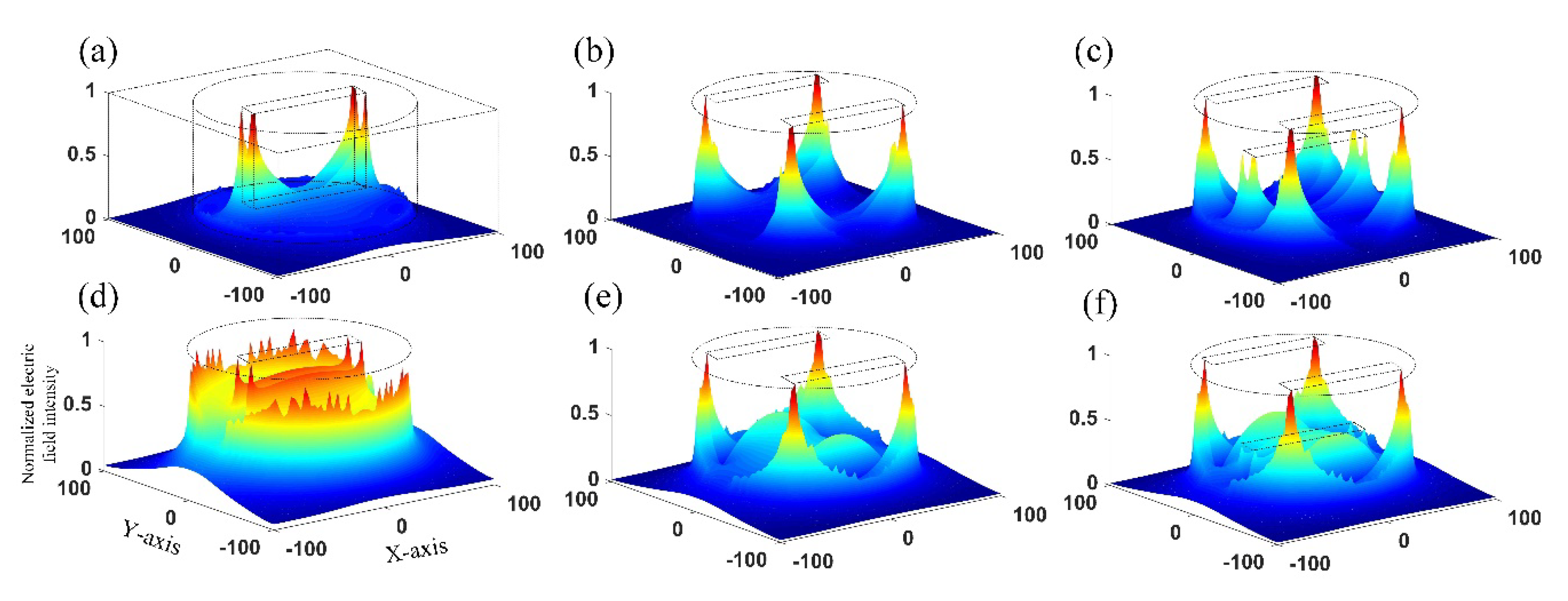
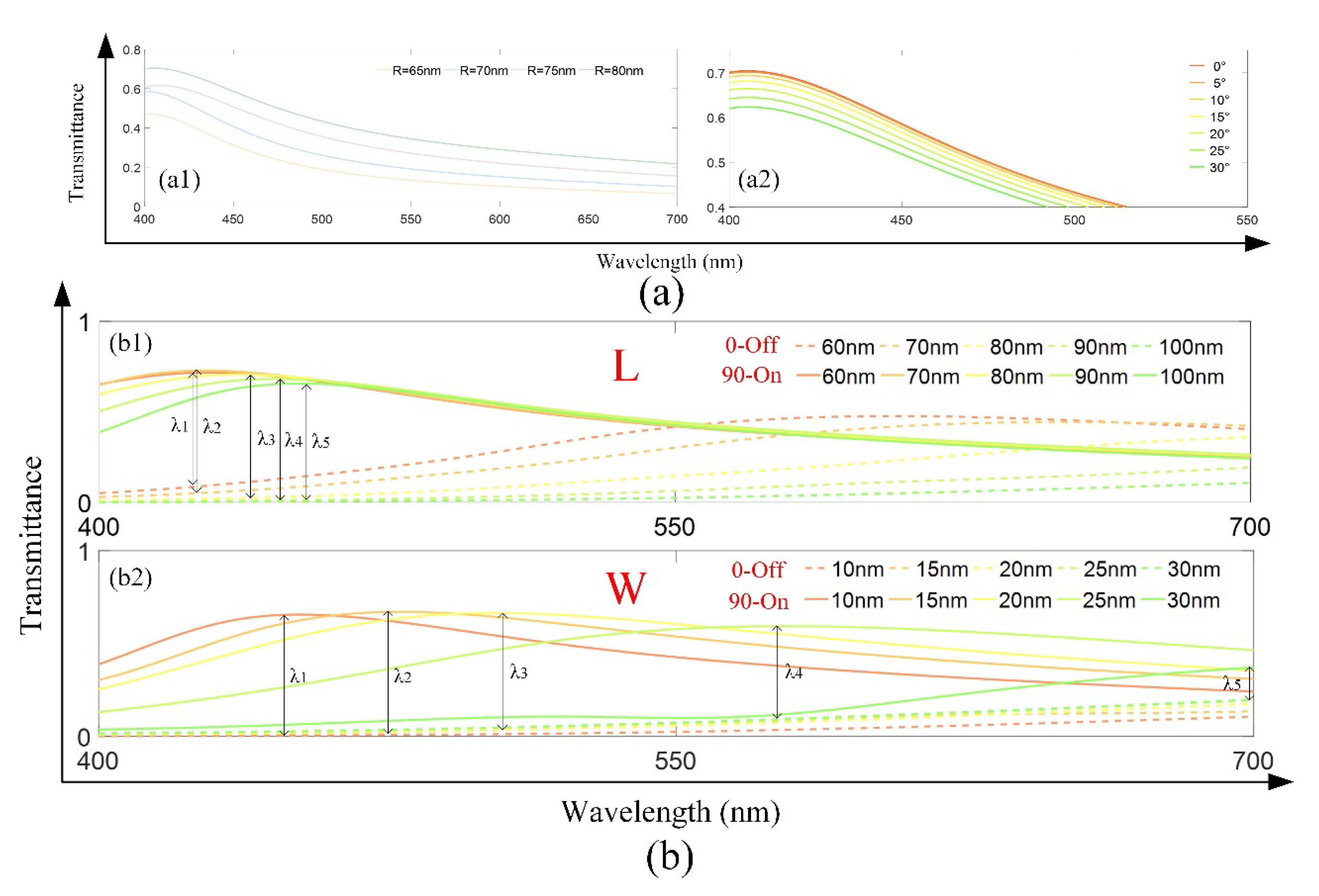
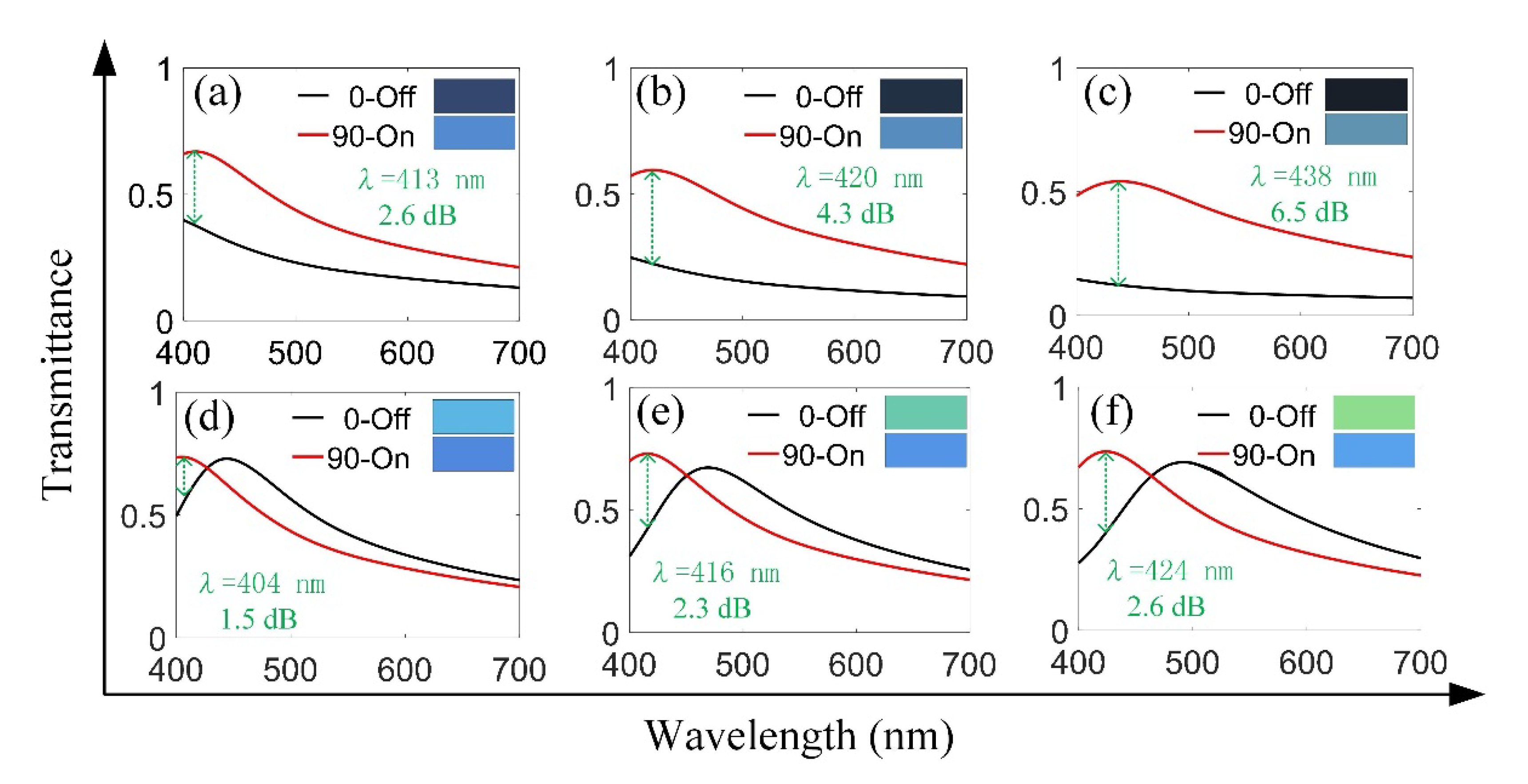

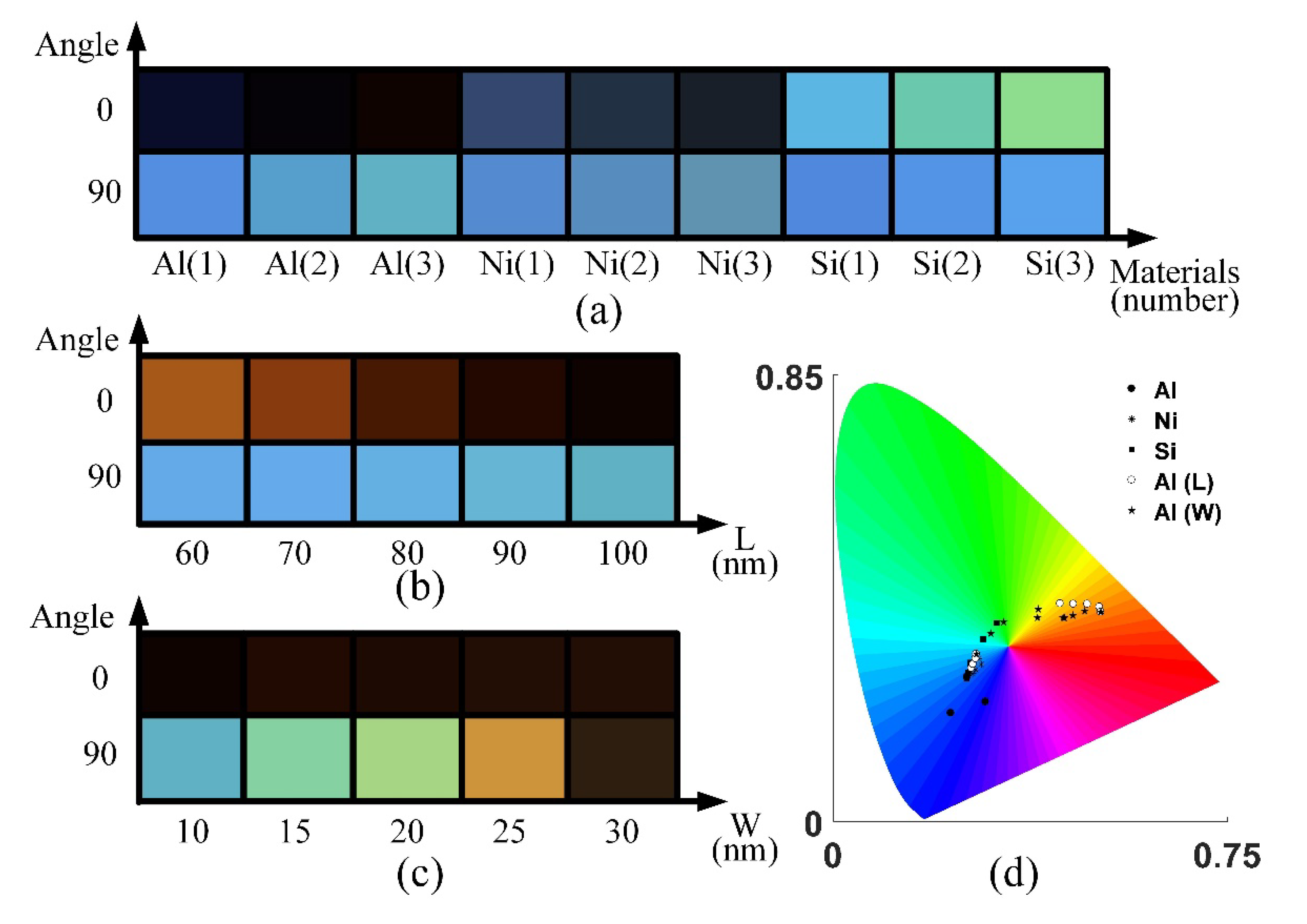
| Al | Ni | Si | |||||||
|---|---|---|---|---|---|---|---|---|---|
| Number of metal strips | 1 | 2 | 3 | 1 | 2 | 3 | 1 | 2 | 3 |
| The working wavelength (nm) | 411 | 442 | 450 | 413 | 420 | 438 | 404 | 416 | 424 |
| The contrast ratio (dB) | 8 | 13.8 | 20.3 | 2.6 | 4.3 | 6.5 | 1.5 | 2.3 | 2.6 |
| L | W | |||||||||
|---|---|---|---|---|---|---|---|---|---|---|
| Size (nm) | 60 | 70 | 80 | 90 | 100 | 10 | 15 | 20 | 25 | 30 |
| The working wavelength (nm) | 426 | 428 | 437 | 446 | 453 | 453 | 479 | 502 | 577 | 698 |
| The contrast ratio (dB) | 9 | 11.6 | 15.5 | 18.3 | 21.2 | 21.2 | 14.3 | 12.8 | 8.2 | 2.7 |
© 2020 by the authors. Licensee MDPI, Basel, Switzerland. This article is an open access article distributed under the terms and conditions of the Creative Commons Attribution (CC BY) license (http://creativecommons.org/licenses/by/4.0/).
Share and Cite
Wen, K.; Zhang, Z.; Jiang, X.; He, J.; Yang, J. Numerical Study of a Polarization Selective Visual Optical Switch. Appl. Sci. 2020, 10, 5246. https://doi.org/10.3390/app10155246
Wen K, Zhang Z, Jiang X, He J, Yang J. Numerical Study of a Polarization Selective Visual Optical Switch. Applied Sciences. 2020; 10(15):5246. https://doi.org/10.3390/app10155246
Chicago/Turabian StyleWen, Kui, Zhaojian Zhang, Xinpeng Jiang, Jie He, and Junbo Yang. 2020. "Numerical Study of a Polarization Selective Visual Optical Switch" Applied Sciences 10, no. 15: 5246. https://doi.org/10.3390/app10155246





